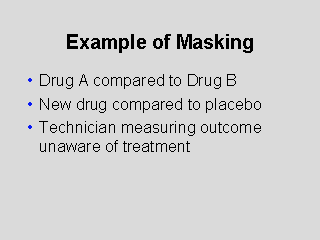 |
When two or more pharmaceutical agents are being compared, masking may be
achieved by ensuring that all treatments appear identical; neither the
patient nor the investigator is informed as to the identity of the
preparation that a patient is receiving. If the objective is to evaluate a
new drug in comparison with no treatment, a placebo is used for the
comparison group. A placebo is an inactive agent made to seem identical to
the active agent in terms of appearance and mode of administration.
The use of placebo is rare outside of clinical trials for pharmaceutical
agents. For example, in evaluations of new surgical procedures, it is more
difficult (and ethically questionable) to apply
sham
surgeries. Thus, masking in such settings may be limited to the individuals
who are assessing the outcome. For example, in a clinical trial of eye
surgery in which visual acuity is the outcome, the technician measuring
visual acuity would be masked as to treatment assignment to avoid bias in
administration of the visual acuity test.
|
